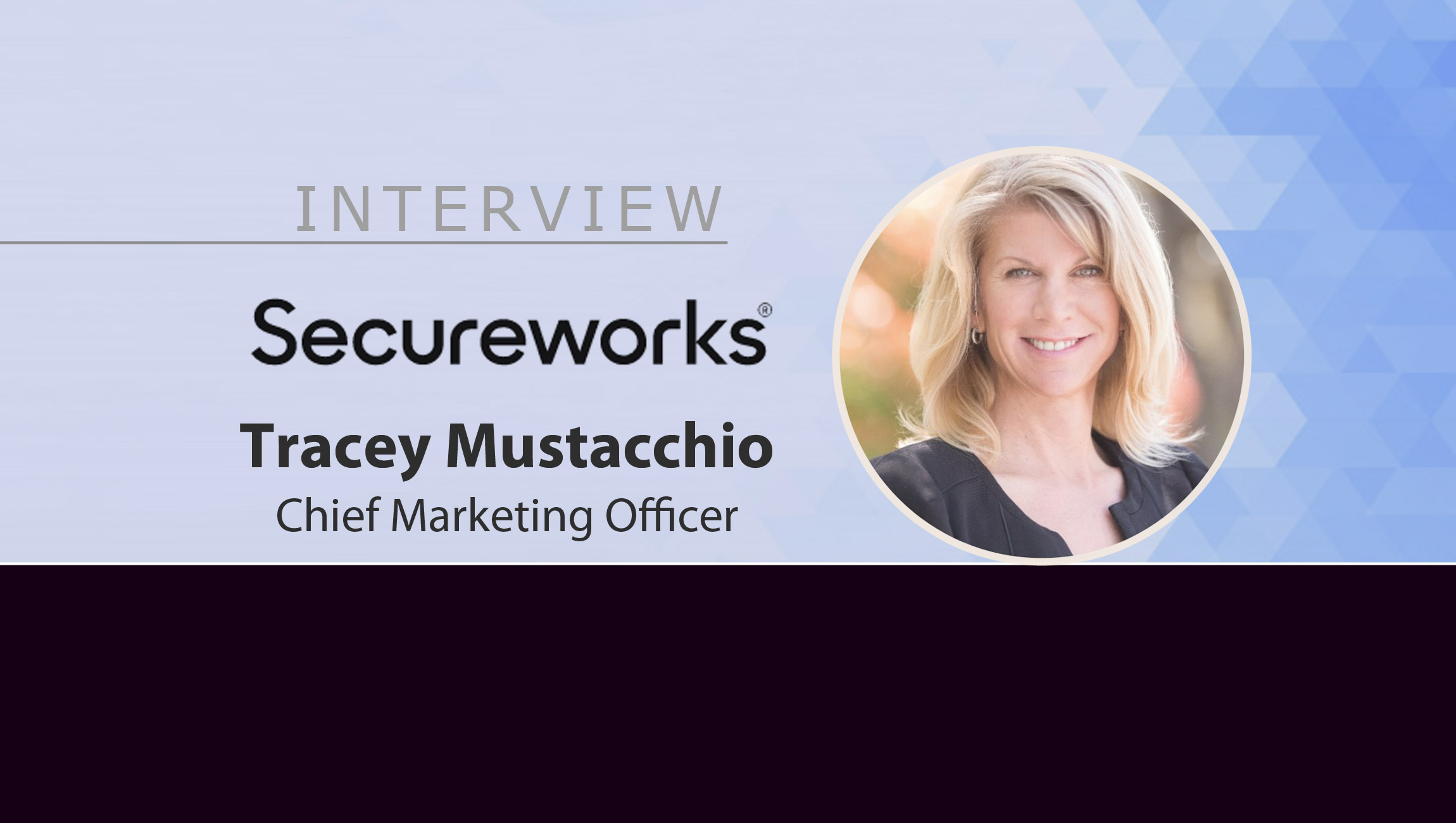The role of the B2B CMO is set to evolve further as newer martech capabilities and marketing processes start redefining the state of B2B marketing in time to come, Tracey Mustacchio, Chief Marketing Officer at Secureworks dives into some top dynamics in this chat:
________
Welcome to this MarTech Series chat Tracey, tell us more about your story so far…what are you most looking forward to in your new role as CMO at Secureworks?
Secureworks is leaning into a company transformation by building on its security services foundation and driving new technology products into market. And it’s happening at an especially critical time for the cybersecurity industry. I’ve been charged with leading that transformation through their global go-to-market capability and product positioning. For me, success will be about moving quickly and surely, ensuring that our customers are happy, and turning our transformation into a major success for us all.
In your view, what are some of the top best practices a new CMO joining a marketing team should be considering before implementing new processes, change or technologies?
Wow. So many things to consider. I’ll give you my top three.
First, every executive at a new-to-them company is greeted with a mix of skepticism, anxiety, and excitement. And since CMOs are sometimes notorious for short tenures, this is especially true for us. So, it’s easy to say that relationships are vital to our success, but in fact, it’s key to our survival. We have to move our teams and our peers and CEOs quickly into transformation. I began preparing for that while I was interviewing with Secureworks. I asked the leaders I met with about company goals and tested for their willingness to support the priorities Marketing would need to drive to meet those goals. Alignment with the CEO and leadership around those expectations is crucial.
Second, I think most CMOs are quick to dive into branding projects because it has such a visible impact. But my background in product pushes me to a different place. I need to dig into the market needs we’re solving and customer perceptions about those needs and our products. For me, it’s customer intimacy that takes precedence over brand, and it starts on Day One.
Finally, none of us succeeds alone. A leader’s first duty is to get the team around you. After 30 days in the role, I’ve had a lot of individual and team meetings, and I’ve recruited them to help me understand things that may not be immediately visible. Things like:
- Are there roadblocks to progress that I should know about now?
- Are there sacred cows I need to deal with – and whose are they?
- What are our business chokepoints; that is, where do we underperform most acutely?
- Where are we strongest? Where do we most consistently win?
No question, there’s a lot to do, there’s a lot to learn and we need to act quickly on behalf of our customers. But beginnings like this are also exhilarating and inspirational. We mustn’t forget to enjoy the ride, too.
How have you seen the role of the CMO evolve over the years? What will the typical tech CMO of the future need to shape up to look like?
CMOs used to be known for brand and creativity. We were the go-to people for putting a wrapper on things. Just to be frank, some of those old school attitudes are still out there, and maybe some CMOs haven’t leapt forward just yet.
But today’s CMO has vastly more complex responsibilities centered around positioning, revenue growth, and customer centricity, because we are closer to revenue than ever before. And because of that, brand today has taken on a more holistic meaning. We must be constantly attuned with customers and buyers and aligning all of our engagement to the buyer’s journey, both pre and post purchase. In today’s digital world, customers often identify their shortlist of potential solutions before ever speaking to a person.
And as a result, we need a loud voice at the table when it comes to shaping future product and solution direction. And we can’t be successful without mastering the art and science of applying marketing technology.
As martech evolves and impacts the way marketing functions and plans campaigns, what martech best practices should teams be keeping in mind?
I heard recently that there are over 7,000 martech providers now. The sheer size and complexity of martech is staggering. Consider that we call martech a stack because there isn’t one technology that can do all that we need. Even marketing clouds are only part of the solution. We have to be very focused on integration and extensibility, and carefully balanced about choosing suites vs. best of breed.
More specifically, closed loop marketing has to be a top priority. And, sadly, I can’t recall just walking into a company and finding a smoothly operating closed loop system — not once. There are always gaps in data, and sometimes those gaps are massive. You just have to tackle them no matter how complex the challenge.
Having the proper data, processes and reporting can make or break a marketing team.
A few thoughts on the future of martech and marketing?
We’re just beginning to see the ability to engage customers and buyers contextually, and to probe for insights that can be gleaned in near real time. I believe AI holds tremendous promise, but we need to move quickly beyond the hype and focus on platforms that are delivering those capabilities now. The time is coming when it will be very difficult to sell any technology that doesn’t deliver AI capabilities. And the more we marketers take AI seriously in the martech stack, the sooner that day will come.
Beyond that, I look forward to technology breakthroughs in ease of use — especially those that will make it much easier to get data out of our own systems. Natural Language Processing, for example, is pretty exciting if we can ever get it out of automated attendants and into our offices. This is important because really complex martech stacks mean we have to spend our money developing complex skill sets to operate them, or even hiring people who are dedicated to interacting with systems all day. This isn’t the best use of our funds. Ease of use is more of a strategic consideration than many realize.
Some martech tools you feel marketers in B2B and tech today need to integrate into their overall tech stack and why?
Marketing automation is key because it delivers the digital engagement that underpins our prospect and eventually customer relationships. But we shouldn’t think of it as a silo. There are platforms available that are seamlessly integrated with CRM, or with web CMS. Those are powerful combinations. Simply put, platforms that support our market engagement more broadly are more valuable.
Something I’ve done in the past is re-invent my teams to actively search for and experiment with marketing innovations. I’ve written MBOs based on identifying, testing, and evaluating something new each quarter. And not necessarily technology innovation, either, but innovations in process. It’s good to challenge the team with taking a fresh look at how we get things done.
Some last thoughts and takeaways for marketing leaders to keep in mind through 2021?
First, tune in to your customers. Listen to what they’re telling you every day. Be their chief advocate, their “whisperer,” and trust them. Trust them to steer you down the best paths for the success of your business. But don’t stop there. Think about their potential future needs. This means monitoring technology shifts, and market shifts like competitive disruptions. It means being aware that when disruption occurs within your target market, it may not begin with your customers. So, tune in to your customers by all means – but view them as a segment of your broader market. And strive to be led by your market.
We’re all coming out of one of the toughest times many of us have ever experienced. It’s more important than ever that we take care of those around us and help each other to be the best that we can be.
And, like I said before, don’t forget to enjoy the ride!

Based in Atlanta, Georgia, Secureworks is a global cybersecurity leader that protects customer progress with Secureworks® Taegis™, a cloud-native security analytics platform built on 20+ years of real-world threat intelligence and research, improving customers’ ability to detect advanced threats, streamline and collaborate on investigations, and automate the right actions.
As Secureworks’ Chief Marketing Officer, Tracey is responsible for leading global marketing strategy, including demand generation, product and field marketing, brand marketing, channel marketing and corporate communications.
Tracey has a well-established record of leadership at the intersection of cybersecurity, information management and data analytics. She has led transformation and growth strategies for McAfee, Nuance, and Secure Software, as well as global go-to-market for IBM’s Big Data portfolio. Prior to Secureworks, she led marketing for Carbonite and Webroot, taking them through their successful acquisition by Opentext.
Tracey is an accomplished marketing leader and innovator who relentlessly focuses on customers and data to forge new pathways and drive measured results. She’s known for pushing organizational boundaries in the pursuit of better customer experience, building high performance teams, and driving go-to-market and product transformations to accelerate company growth. Tracey is a graduate of Virginia Wesleyan College and a Wesleyan Scholar. She received degrees in Math/Computer Science and Philosophy.






